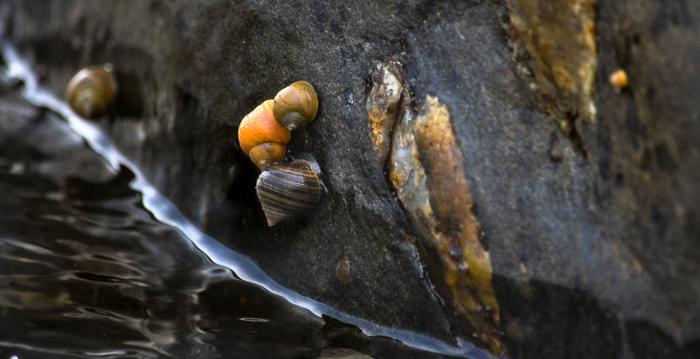**Strictly embargoed until 19:00 GMT on Thursday 4 January 2024**
Biologists uncover the secrets of evolutionary change
Images available here

Credit: Daria Shipilina
**Strictly embargoed until 19:00 GMT on Thursday 4 January 2024**
Biologists uncover the secrets of evolutionary change
Images available here
- Big evolutionary changes happen gradually and not in giant leaps, a team of biologists led by the University of Sheffield have discovered
- Using new methodology to study an evolutionary shift in the birthing style of marine snails, experts have been able to answer the long-debated question as to how game-changing innovations like flight, vision, and the bearing of live offspring happened
- Understanding the evolutionary origin of these developments is important because they can dramatically change the course of evolution, such as when live-bearing led to the diversification of mammals or feathers helped birds to evolve flight
- Biologists will now be able to apply these new methods to other types of adaptation, including thermal tolerance, which must evolve if some species are to survive climate change
Significant evolutionary changes happen gradually as opposed to in dramatic ‘monster’ steps, biologists have discovered, answering the long-debated question as to how game-changing innovations like flight, vision, and the bearing of live offspring came to be.
Evolution is usually a gradual process, taking place over small, incremental steps, but occasionally producing striking new functions, like feathers that eventually allowed birds to fly.
Until now, it has been difficult to understand how these significant evolutionary changes have happened, partly because many of them took place so long ago and partly because it is hard to imagine intermediate stages. Some have suggested that they occur in big steps, when large-effect mutations give rise to ‘hopeful monsters’; others have argued that innovations are built gradually, with natural selection favouring intermediate steps.
By obtaining and studying whole-genome sequences from a group of marine snails, which have made a recent shift from egg-laying to live-birth, scientists at the University of Sheffield and their collaborators at the University of Gothenburg and Institute of Science and Technology Austria, are now able to settle the debate for at least one example.
The study used new methodology to discover whether this new shift in birthing style happened rapidly or gradually, findings which could then be applied to help explain other dramatic shifts in evolution.
Scientists were able to identify 50 genes that are perfectly associated with reproductive mode, as well as estimate the time of their origin. The results showed they accumulated gradually, spreading at different times in the past. This demonstrates that innovation can evolve progressively, rather than in a single evolutionary step.
Professor Roger Butlin, from the University of Sheffield’s School of Biosciences, said: “The evolutionary origin of key innovations is important to understand because they can dramatically change the course of evolution, like when live-bearing led to the diversification of mammals or feathers helped birds to evolve flight. Until now however, there have been few opportunities to study these, mainly because most evolutionary changes happened so long ago.
“By discovering and studying the recent evolutionary shift in the way marine snails give birth, we’re now able to understand these major changes and apply our methods to many other evolutionary shifts.”
He added: “Our results will change the way biologists view major evolutionary transitions, shifting the focus away from big leaps in evolution towards understanding the progressive benefits of small evolutionary steps. They will also help others dissect the genetic and historical basis of other adaptive traits, which is important when many organisms are being forced to adapt rapidly to a changing world.”
The team now plan to study the functions of the genes they have identified, in order to understand the series of evolutionary steps that led to live birth. They also hope that their methods will be applied to other types of adaptation, including things like thermal tolerance, which must evolve if some species are to survive climate change.
Media contact: Shemina Davis, Senior Media Relations Manager, 0114 222 5339 or [email protected]
Further information
The University of Sheffield
The University of Sheffield is a leading Russell Group university, with a world-class reputation. Over 30,000 students from 150 countries study at Sheffield. In a truly global community, they learn alongside over 1,500 of the world’s leading academics.
Sheffield’s world-shaping research feeds into its excellent education. Students learn at the leading edge of discovery from researchers who are tackling today’s biggest global challenges.
Driven by outstanding people, staff and students share a commitment to changing the world for the better, through the power and application of ideas and knowledge.
From the first documented use of penicillin as a therapy in 1930, to building Europe’s largest research-led manufacturing cluster, Sheffield’s inventive spirit and top quality research environment sets it apart.
Current research partners include Boeing, Rolls-Royce, Unilever, AstraZeneca, GlaxoSmithKline, Siemens and Airbus, as well as many government agencies and charitable foundations.
Sheffield’s Students’ Union has won the Whatuni Student Choice Award for Best Students’ Union for six consecutive years. Students can choose from 350 societies and clubs, or join over 2,000 volunteers.
Over 300,000 Sheffield alumni from 205 different countries make a significant influence across the world, with six Nobel Prize winners included amongst former staff and students.
To find out more, visit: www.sheffield.ac.uk
Journal
Science
Method of Research
Experimental study
Subject of Research
Animals
Article Title
The genetic basis of a recent transition to live-bearing in marine snails
Article Publication Date
5-Jan-2024




